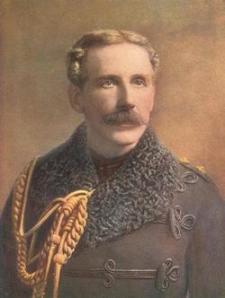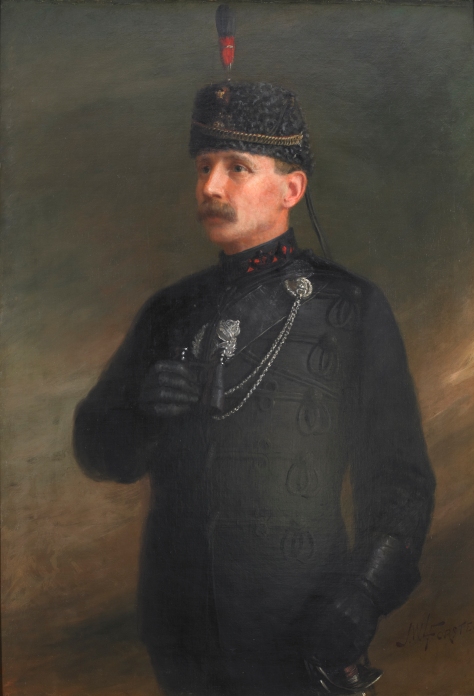General Sir William Dillon Otter, KCB, CVO, VD was a Captain and Adjutant of The Queen’s Own Rifles when he first went into action at the Battle of Ridgeway in 1866, fighting against Fenians loyalists who invaded what was then Upper Canada.
As Lieutenant Colonel, he was Commanding Officer of The Queen’s Own from 1875 until 1883. He then became Commander of the Infantry School Corps (later named the Royal Canadian Regiment) in the newly formed Canadian Permanent Force.
In 1885, now a Colonel, he commanded the Battleford Column in Western Canada during the North-West Rebellion and ill-advisedly attacked Cree Chief Poundmaker’s reserve at Cut Knife where the Cree and Assiniboine bands of Battleford Agency were gathered. After six hours of defensive fighting, and with fourteen wounded and eight dead soldiers, Otter withdrew his column to Battleford .
In the South African (or Boer) War of 1899-1902 Otter commanded the Royal Canadian Regiment Special Service Battalion, which included members of The QOR.
He wrote “The Guide: A Manual for the Canadian Militia (Infantry) Embracing the Interior Economy, Duties, Discipline, Drills and Parades, Dress, Books, and Correspondence of a Battalion with Regulations for Marches, Transport & Encampment, Also Forms & Bugle Calls“ in 1914, which includes sections on discipline, courts martial, offences, complaints, and defaulters.
During the First World War he came out of retirement to command operations for the internment of enemy nationals resident in Canada.
Most famously though perhaps least well known of his accomplishments, Otter headed the Otter Commission. The Otter Commission was tasked to establish links of perpetuation from the units of Canadian Expeditionary Force back to the institutionally separate units of the Canadian Militia in the years following the First World War. This establishment of perpetuation, based primarily on geographical connections through original recruiting areas of the CEF battalions, provided a basis by which the achievements and battle honours of the CEF units transferred back to the units of the standing Militia. Without this work of the Otter Commission the CEF and its achievements would have had no continuance with existing units of the Canadian Army today.
Before his death in 1929 he achieved the rank of General and had been Chief of General Staff in Ottawa.
His Funeral
“For two days the general lay in state at the University Avenue Armouries. Day and night four sentries stood with arms reversed at the catafalque. Thousands of Toronto citizens passed to pay their respects no so much because he was Canada’s first native born general but because in his deeds and thoughts he epitomized Canada.
The funeral was fully military: the gun carriage; the casket with the General’s headdress atop the Union Jack; the led riderless horse with the jack boots reversed in the stirrups; the Regimental Sergeant Major bearing on a cushion the decorations and medals; the firing party with arms reversed; the detachments from every unit in the city; and over all the slow measured tread to the Dead March from Saul played with muffled drums. It was a fitting last tribute to one who had laboured mightily and fought heroically for the land he loved.” (The Queen’s Own Rifles of Canada, Barnard, pp131-132)
Partial Service Record
- Joined the Victoria Rifle Company (No. 6 Company) as a private
- Became Staff-Sergeant October 21, 1964 and then Lieutenant in the 2nd Administrative Battalion at Niagara 1864-65
- On return was appointed Lieutenant of No. 1 Company May 19th, 1865
- Appointed Adjutant August 19th, 1865
 Served as Adjutant during Fenian Raid, 1866
Served as Adjutant during Fenian Raid, 1866- Captain, March 8th, 1866
- Major, June 4th, 1869
- Brevet Lieutenant-Colonel, June 4th, 1874
- Gazetted Lieutenant-Colonel in command May 29th, 1875
- Transferred to Infantry School Corps December 21st , 1883, and appointed Commandant Royal School of Infantry at Toronto
- Adjutant of Wimbledon Team of 1873 and Commandant of the team of 1883
- Commanded at Pilgrimage Riots, October, 1875
- Commanded at Belleville Riots, 1877
- Commanded Battleford Column, Northwest Field Force, at relief of Battleford, and action of Cut Knife Creek April-July, 1885
- Appointed to command of No. 2 Military District July 1st, 1886
- Inspector of Infantry May 16th, 1896
- Commanded Service Battalion Royal Canadian Regiment during South African War, 1900
- Gazetted Colonel July 19th, 1900
- Decorated by H. M. King Edward VII, as Companion of the Bath, 1901
- District Officer commanding Military District No. 2
- 1908-1910 promoted Brigadier General and Chief of the General Staff (first Canadian to hold this position)
- 1910-1912 Inspector General
- 1913 he was made a Knight Commander of the Order of the Bath
- 1914-1918 Director of Internment Operations in Canada


